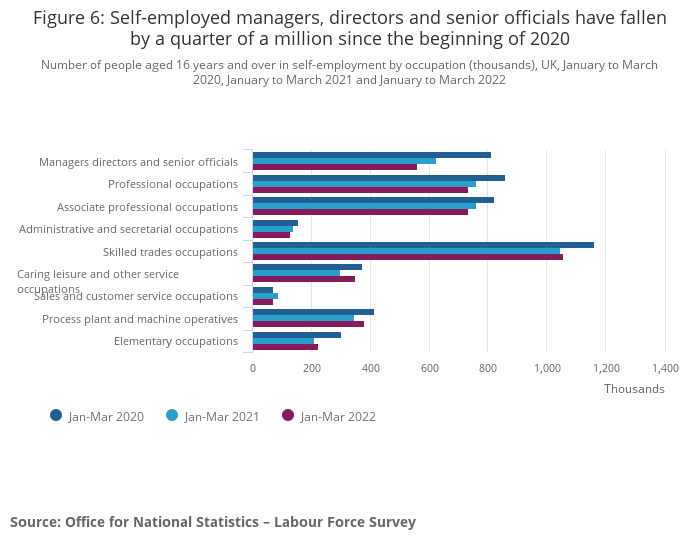Solo self-employed numbers nosedive says report
Government report reveals there were large falls in the number of solo self-employed in the most highly skilled occupations over the past two years. But sadly, the government report did not remark on the findings being worrying.
Self-employment appears to have fallen most sharply over the past two years among those in managerial, director and senior roles. The figures were down 30.9% from 811,000 in January to March 2020 to 560,000 in January to March 2022. Those in professional occupations saw self-employment numbers down 14.8% from 861,000 to 733,000 in the same period, according to a new report published by the UK government.
At the same time, there has been a large percentage fall in self-employed workers in elementary positions, reducing by around a quarter (25.5%) from 302,000 in January to March 2020, to 225,000 in January to March 2022.
Self-employed managers, directors and senior officials have fallen by a quarter of a million since the beginning of 2020

Between January to March 2020 and January to March 2022, the number of self-employed people working for themselves fell by 14.6% from 3.5 million to 2.9 million. There were also notable decreases among those running a business or professional practice and sole directors of their own business (down by 180,000 (17.7%) and 170,000 (22.6%), respectively in the same period). Decreasing trends have also been observed among sole proprietors in UK businesses in recent years.
In January to March 2022, the number of those doing freelance work appeared to have recovered most, to just 36,000 (5.5%) below the level in January to March 2020 (645,000).
Demographic changes in self-employment
Falls in self-employment have been highest among men and workers aged 45 to 54 years
In January to March 2020, there were 3.3 million men (65.6% of all those in self-employment) and 1.7 million women (34.4%) in self-employment. This represented a slight decrease for men (33,000) but an increase for women (85,000) compared with the same quarter in 2019.
During the coronavirus (COVID-19) pandemic, numbers fell most sharply among men, down to 2.7 million in January to March 2022 (16.5% lower than the same quarter in 2020). This was the lowest level of male self-employment for over a decade.
Among women, self-employment fell by 11.4% between January to March 2020 and January to March 2022, down to 1.5 million women, the lowest level since 2016.
In terms of age, the largest fall among self-employed workers was seen in those aged 45 to 54 years, from 1.3 million in January to March 2019 to 1.1 million in January to March 2022. Despite this, the average (mean) age of people in self-employment has remained fairly steady at 47.5 years in January to March 2019 and 47.6 years in January to March 2022. In comparison, the average age of employees in these two periods was 40.6 years and 40.9 years, respectively.
Why did so many people reclassify their employment status?
More workers flowing out of self-employment into employee status stayed in the same job (“reclassified”) than changed job. For example, flows of people aged 16 to 64 years from self-employment in the previous quarter to employee status by whether or not they changed job (thousands, not seasonally adjusted), January to March 2019 to January to March 2022.
No surprise for Freelance Informer readers was another factor that affected the way people classify their employment status, which was the announcement in the 2018 Budget of reforms designed to tackle non-compliance with off-payroll working rules (sometimes known as “IR35“).
The industry with the highest number of workers reclassifying in both 2019 to 2020 and 2020 to 2021 was banking and finance at 137,000 (68.3%) and 109,000 (55.5%), respectively.
“These rules make sure that workers, who would have been an employee if they were providing their services directly to the client, pay broadly the same Income Tax and National Insurance contributions as employees,” said the government report.
The reforms were expected to be implemented on 6 April 2020 but were postponed for one year as part of the government’s response to COVID-19.
Before the reforms were implemented in April 2021, 155,000 workers (72.8%) who moved from self-employment to employee status in January to March 2021 reclassified, but this then fell to 88,000 (62.2%) in April to June 2021. In the latest period (January to March 2022), the numbers of workers reclassifying (not changing) and changing their job were closer, at 75,000 (53.5%) and 66,000 (46.5%), respectively.
Looking at flows between 2019 and 2020, 61,000 people who were self-employed in the professional, scientific and technical activities sector moved to become employees, of which 84.3% remained in this sector. Between 2020 and 2021, 33,000 left self-employment to become an employee, of which 71.4% stayed in this industry.
Sectors with biggest fluctuations in self-employment numbers
Of those moving from self-employment in the construction industry to become employees between 2019 and 2020, similar numbers changed (22,000) and did not change industry (21,000). In the following year (2020 to 2021), 8,000 left self-employment in construction to work as an employee in a different sector, with just 1,000 remaining in construction as an employee.
The extent of reclassification (changing employment status without changing job) among people moving from self-employment to employee status appeared to be relatively mixed across industry sectors.
The industry with the highest number of workers reclassifying in both 2019 to 2020 and 2020 to 2021 was banking and finance at 137,000 (68.3%) and 109,000 (55.5%), respectively.


